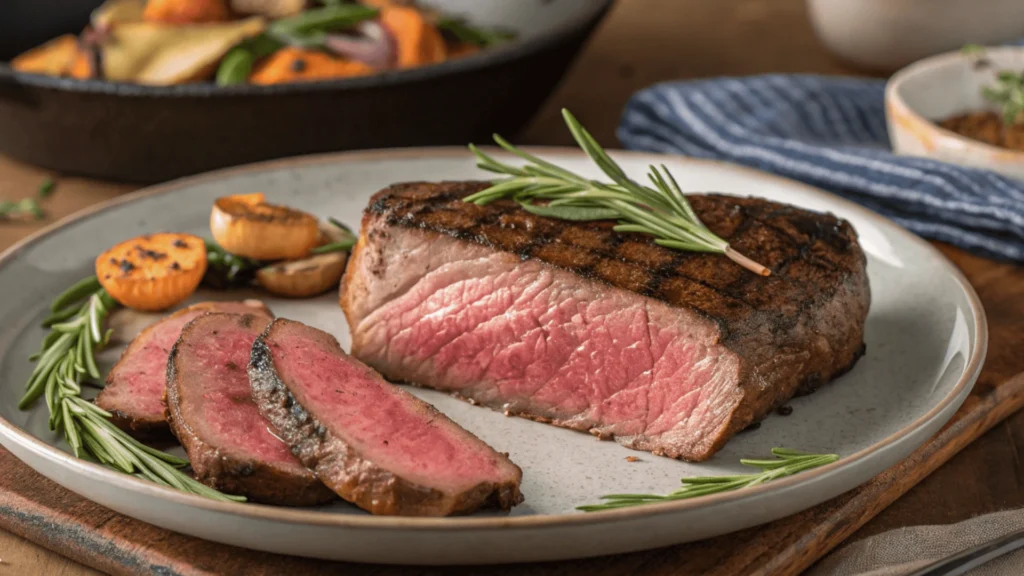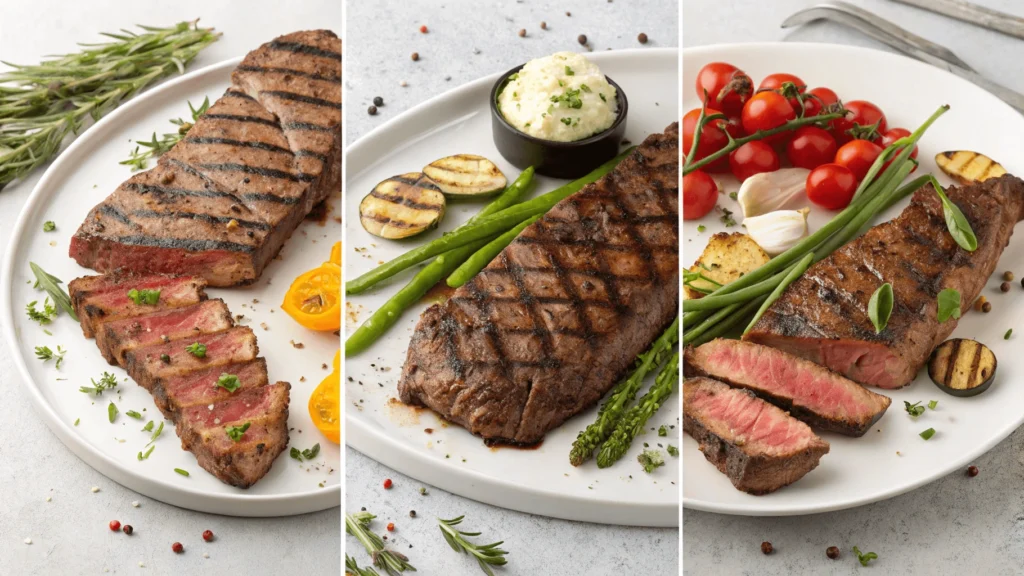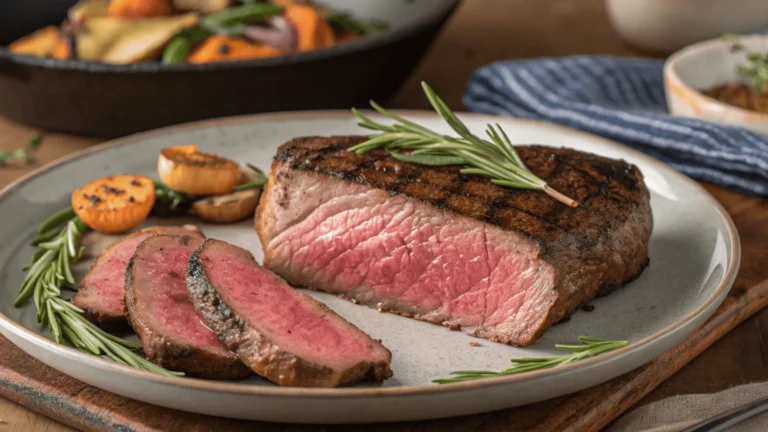Table of Contents
Quick description on Steak Beef
Cooking the perfect beef strip steak at home can feel like an intimidating task, but with the right technique, it’s incredibly simple! Whether you’re a seasoned cook or a beginner in the kitchen, mastering this juicy and tender cut of meat is a game changer. From the sizzling sear to the rich, savory flavor, a perfectly cooked beef strip steak is sure to impress. In this guide, we’ll walk you through everything you need to know to cook the perfect steak every time—from choosing the right cut to

What Is Beef Strip Steak?
Beef strip steak, often referred to as New York strip or sirloin strip, is one of the most flavorful and tender cuts of beef. It originates from the short loin area of the cow, situated along its back. This cut has a perfect balance of tenderness and beefy flavor, making it a popular choice for grilling, pan-searing,
Unlike fattier cuts like ribeye, the beef strip steak has a moderate amount of marbling, which contributes to its rich taste without being too greasy. The meat is lean, with a slight fat cap on the edge, adding to its flavor profile while keeping it tender and juicy when cooked properly.
Whether you’re preparing a special dinner or just craving a classic steak night, the beef strip steak is a versatile option that delivers on taste and texture every time. Let’s dive into the steps to cook it perfectly!
Key Benefits of Beef Strip Steak
Beef strip steak isn’t just a delicious meal option—it’s packed with nutrients and offers several benefits for your health when enjoyed as part of a balanced diet. Here’s why you should consider making it a regular part of your culinary repertoire:
- High in Protein: Beef strip steak is an excellent source of high-quality protein, which is essential for building and repairing muscles. Protein also helps keep you full and satisfied, making it a great option for anyone looking to maintain or build lean muscle mass.
- Rich in Iron: As a red meat, beef is a fantastic source of heme iron, the type of iron most easily absorbed by the body. Iron is vital for oxygen transport, energy production, and overall health, making beef strip steak a great choice for those needing an iron boost.
- Packed with Vitamins and Minerals: Beef strip steak is rich in B-vitamins, particularly B12, which supports the nervous system and helps prevent anemia. It also contains zinc, selenium, and phosphorus—minerals that play key roles in immune function, bone health, and metabolism.
- Tasty and Versatile: Beyond its nutritional benefits, beef strip steak is incredibly versatile. You can grill, pan-sear, or broil it to perfection, and pair it with a variety of sides, sauces, and seasonings to suit your tastes.
- Satisfying Texture and Flavor: The beef strip steak has the perfect balance of tenderness and chew, making it a satisfying cut of meat that delivers on flavor without being too rich or fatty.
How to Choose the Best Beef Strip Steak
When it comes to cooking a perfect beef strip steak, choosing the right cut is essential. Here’s what to look for when selecting the best beef strip steak for your next meal:
- Check for Marbling: Marbling is the small streaks of fat within the muscle fibers, and it plays a crucial role in determining the flavor and tenderness of the meat. The more marbling, the more flavorful and juicy the steak will be. Opt for steaks with a moderate to high amount of marbling for the best eating experience.
- Check the Color: Fresh beef strip steak should have a deep red color. If the steak looks brown or gray, it may not be fresh. Avoid any steaks with excessive discoloration, as it could indicate poor quality or age.
- Thickness Matters: A good beef strip steak should be at least 1-inch thick, but thicker cuts are even better for achieving a perfect sear while keeping the inside tender and juicy. A thicker steak will also allow for better control over the level of doneness.
- Bone-in or Boneless: While boneless beef strip steaks are more common and easier to cook, bone-in steaks offer extra flavor. The bone helps retain moisture and adds depth to the flavor during cooking. If you prefer the best flavor, consider going for a bone-in cut.
- Grade of Beef: The grade of beef will affect both the taste and texture of your steak. USDA Prime is the highest grade, offering exceptional marbling, while USDA Choice is still a high-quality option. USDA Select is leaner and less flavorful, so if you want a steak with a rich taste, look for Prime or Choice.
By considering these factors when selecting your beef strip steak, you’ll set yourself up for success in the kitchen, ensuring a mouthwatering dish every time.
How to Cook Beef Strip Steak to Perfection
Cooking a beef strip steak perfectly is all about timing, temperature, and technique. Whether you prefer it rare, medium, or well-done, following the right steps will ensure a flavorful and tender result.
1. Prepare Your Steak
Start by taking your beef strip steak out of the fridge about 30 minutes before cooking to bring it to room temperature. This ensures even cooking throughout. Pat the steak dry with paper towels to remove excess moisture — this is crucial for getting a good sear.
2. Season Generously
Beef strip steak has great flavor on its own, but the right seasoning takes it to the next level. Sprinkle both sides generously with coarse salt and freshly ground black pepper to bring out its rich taste. You can also add garlic powder, onion powder, or your favorite steak rub to taste. The key is to season generously for a bold flavor.
3. Choose the Right Cooking Method
There are several methods for cooking a beef strip steak, but pan-searing or grilling are the most popular and effective ways to achieve a beautifully cooked steak.
- Pan-Searing (Stovetop):
- Heat a heavy skillet (cast iron is ideal) over medium-high heat.
- Add a tablespoon of oil to the pan and let it heat up until it shimmers.
- Once the oil is hot, add the steak and sear for about 4-5 minutes on each side for medium-rare, depending on the thickness of the steak. For a thicker steak, you may need to finish it in the oven for a few minutes.
- For extra flavor, add a couple of tablespoons of butter and herbs (like thyme or rosemary) during the last 2 minutes of cooking. Baste the steak with the melted butter to add extra richness and depth of flavor.
- Grilling:
- Preheat your grill to medium-high heat, around 450°F to 500°F, for the perfect sear.
- Place the steak on the grill and cook for about 4-5 minutes per side for medium-rare. Modify the cooking time to match your desired level of doneness.
- If you want grill marks and a smoky flavor, make sure the grill grates are well-oiled and the grill is preheated properly.
4. Check Doneness with a Meat Thermometer
For precise cooking, use a meat thermometer to check the internal temperature of your beef strip steak:
| Doneness Level | Temperature Range |
|---|---|
| Rare | 120°F – 125°F |
| Medium-Rare | 130°F – 135°F |
| Medium | 140°F – 145°F |
| Medium-Well | 150°F – 155°F |
| Well-Done | 160°F and above |
If you don’t have a thermometer, use the “touch test” method: press the steak with your finger and compare its firmness to the feeling of your palm when relaxed (rare) or when pressed (well-done).
5. Rest Your Steak
After cooking, let your beef strip steak rest for at least 5-10 minutes before slicing into it. This helps the juices spread evenly through the steak, making it tender and full of flavor.
6. Slice and Serve
After letting the steak rest, slice it against the grain for maximum tenderness. Pair it with your favorite sides like roasted veggies, creamy mashed potatoes, or a crisp, fresh salad. Enjoy your perfectly cooked beef strip steak!
Ingredients Table
| Ingredient | Amount | Notes |
|---|---|---|
| Beef strip steak | 2 steaks (8–10 oz each) | Look for well-marbled cuts |
| Olive oil | 2 tablespoons | For searing |
| Garlic powder | 1 teaspoon | Or use fresh minced garlic if preferred |
| Onion powder | 1 teaspoon | Adds a mellow flavor |
| Salt | To taste | Kosher salt is ideal |
| Black pepper | To taste | Freshly cracked for the best flavor |
| Fresh rosemary or thyme | 2 sprigs (optional) | For enhanced aroma |
| Butter | 2 tablespoons (optional) | For basting during final sear |
Step-by-Step Instructions
Step-by-Step Instructions
- Remove the beef strip steaks from the fridge about 30 minutes before cooking. This helps them cook evenly.
- Season the Steak
Pat steaks dry with paper towels. Brush both sides with olive oil, then season generously with salt, pepper, garlic powder, and onion powder. You can add fresh herbs, such as rosemary or thyme, if desired. - Preheat Your Pan
Place a heavy skillet, ideally cast iron, over medium-high heat. Allow it to heat up—this is key for achieving a perfect sear. - Sear the Steak
Add a bit of oil to the pan. Once it shimmers, carefully place the steaks in the skillet.
For Medium-Rare: Sear for approximately 3–4 minutes on each side.
Don’t move the steak while searing to develop a crust.
- Baste with Butter (Optional)
In the last minute of cooking, toss butter and herbs into the pan to infuse the steak with flavor. Tilt the skillet and spoon the melted butter over the steaks, infusing them with extra richness and flavor. - Check Internal Temperature
Use a meat thermometer to ensure perfect doneness. See the temperature table below if needed. - Rest the Steak
Remove steaks from the pan and let them rest for 5–10 minutes before slicing. This lets the juices settle back into the meat, ensuring it stays tender.

Pro Tips and Variations for Cooking Beef Strip Steak
1. Let It Rest After Cooking
While it may be tempting to dig in right away, resting your beef strip steak after cooking is essential. Allowing the steak to rest for 5–10 minutes ensures that the juices redistribute throughout the meat, making every bite flavorful and tender. It also helps prevent the juices from spilling out when you cut into the steak.
2. Sear on High Heat for a Perfect Crust
The secret to that mouthwatering, crispy crust on your steak? High heat! Searing the steak quickly over high heat locks in the juices while developing a beautiful golden-brown exterior. A cast-iron skillet or heavy pan works best for this.
3. Experiment with Marinades
While beef strip steak is flavorful on its own, marinating it can elevate its taste. You can try classic marinades like soy sauce, balsamic vinegar, and garlic, or get creative with herbs like oregano, thyme, or rosemary. Let the steak marinate for at least 30 minutes, or overnight for a deeper flavor.
4. Use Compound Butter for Extra Flavor
Take your beef strip steak to the next level by topping it with compound butter. Combine softened butter with minced garlic, fresh herbs, and a touch of lemon zest, then let it melt over your steak for a rich, aromatic finish.
5. Try Different Cooking Methods
While pan-searing is a quick and effective method, you can also try grilling or broiling your beef strip steak for a slightly different texture and flavor. If grilling, use direct heat for a few minutes per side, ensuring the grill grates are well-oiled.
6. Rest Steak Before Slicing
For the juiciest results, let the steak rest before slicing. This step is crucial because it keeps the juices from spilling out when you cut the meat. If you slice immediately, you risk losing all those savory juices.
7. Pair with Sides That Complement
Beef strip steak pairs wonderfully with roasted vegetables, creamy mashed potatoes, or a fresh green salad. Consider serving it with garlic butter mushrooms or crispy fries for an indulgent twist!
8. Don’t Overcook!
Beef steak is best served medium-rare. Cooking it longer can dry out the meat and make it tougher. Stick to the recommended cooking times and always use a meat thermometer to ensure the best results.
Conclusion
In conclusion, mastering how to cook beef strip steak is all about balancing the right technique with high-quality ingredients. Whether you’re cooking it on the grill, in a cast-iron skillet, or in the oven, the key is to ensure that you achieve the perfect sear while keeping the steak juicy and tender.
Remember to let the steak rest before cutting into it, as this helps the juices redistribute, resulting in a flavorful, succulent bite. Pair your steak with thoughtful side dishes like a fresh salad, garlic butter roasted vegetables, or a rich sauce to complement the savory flavor of the beef.
With these tips and techniques, you’ll be able to cook a beef strip steak that not only meets your expectations but exceeds them. Happy cooking, and enjoy your meal!
My name is Emma. Don’t forget to leave your opinion in the comments. & Thanks

